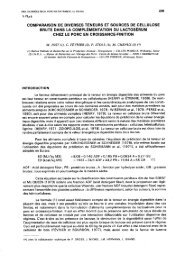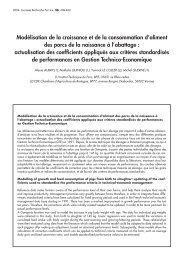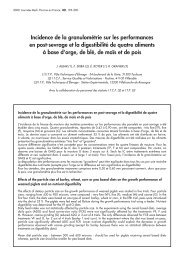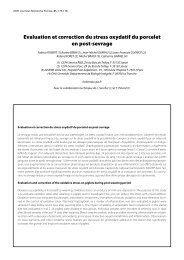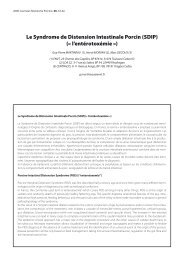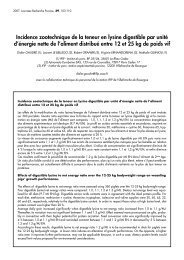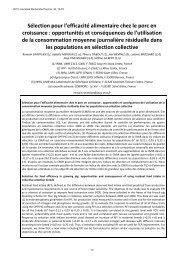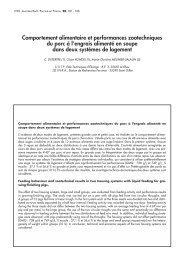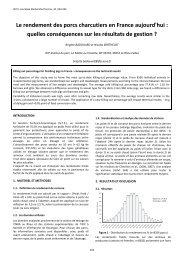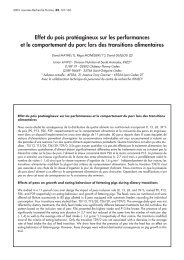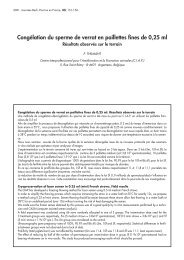Acquisition de l'immunité passive chez le porcelet : - Journées de la ...
Acquisition de l'immunité passive chez le porcelet : - Journées de la ...
Acquisition de l'immunité passive chez le porcelet : - Journées de la ...
Create successful ePaper yourself
Turn your PDF publications into a flip-book with our unique Google optimized e-Paper software.
447<br />
JACOBSEN et al, 2002). Il est alors possib<strong>le</strong> que <strong>le</strong>s différences<br />
<strong>de</strong> concentrations maxima<strong>le</strong>s d’IgG <strong>chez</strong> <strong>le</strong>s porce<strong>le</strong>ts<br />
soient dues à <strong>de</strong>s différences <strong>de</strong> concentrations initia<strong>le</strong>s <strong>de</strong>s<br />
colostrums en IgG. Dans notre étu<strong>de</strong>, el<strong>le</strong>s sont simi<strong>la</strong>ires à<br />
cel<strong>le</strong>s <strong>de</strong> 58 à 70 mg/ml rapportées par JENSEN et PEDER-<br />
SEN (1979), BLAND et al, (2003) et LE DIVIDICH et al,<br />
(2004), mais plus faib<strong>le</strong>s que cel<strong>le</strong>s <strong>de</strong> 86 à 96 mg/ml rapportées<br />
par BOURNE (1969) et KLOBASA et al (1987).<br />
Selon certains auteurs (HENDRIX et al, 1978 ; KOBLASA et<br />
al, 1981), <strong>le</strong>s porce<strong>le</strong>ts qui meurent avant <strong>le</strong> sevrage ont <strong>de</strong>s<br />
taux d’IgG sériques <strong>de</strong> 10 à 50 % inférieurs à ceux <strong>de</strong>s survivants.<br />
On peut alors se <strong>de</strong>man<strong>de</strong>r dans quel<strong>le</strong> mesure <strong>la</strong><br />
concentration maxima<strong>le</strong> en IgG au p<strong>la</strong>teau correspond à une<br />
immunité <strong>passive</strong> satisfaisante. Chez <strong>le</strong> veau, une concentration<br />
éga<strong>le</strong> ou supérieure à 15 mg/ml est considérée comme<br />
suffisante pour assurer une bonne protection contre <strong>le</strong>s infections<br />
(PERINO et al, 1995 ; WITTUM et PERINO, 1995). Chez<br />
<strong>le</strong>s porce<strong>le</strong>ts, COALSON et LECCE (1973) suggèrent qu’“une<br />
heure <strong>de</strong> tétée d’un colostrum <strong>de</strong> bonne qualité immune” est<br />
suffisante pour <strong>le</strong>ur procurer une immunité <strong>passive</strong> satisfaisante<br />
correspondant à 15-17 mg IgG/ml. Selon l’équation 2, ce<br />
niveau d’IgG peut être acquis par une ingestion <strong>de</strong> seu<strong>le</strong>ment<br />
70 g <strong>de</strong> colostrum, <strong>de</strong> bonne qualité immune/kg PVI (soit<br />
98 g pour <strong>de</strong>s porce<strong>le</strong>ts pesant 1,400 kg, en moyenne) dans<br />
<strong>le</strong>s quelques heures suivant <strong>la</strong> naissance. Mais, à cette quantité<br />
<strong>de</strong> colostrum consommé correspond, d’après l’équation 1,<br />
un gain <strong>de</strong> poids négatif (-40 g) <strong>de</strong>s porce<strong>le</strong>ts entre <strong>la</strong> naissance<br />
et 24 heures ce qui constitue un facteur <strong>de</strong> risque pour<br />
<strong>le</strong>ur survie (LE DIVIDICH et al, 2004). En d’autres termes, l’acquisition<br />
d’une immunité <strong>passive</strong> satisfaisante n’est pas une<br />
garantie <strong>de</strong> survie <strong>de</strong>s porce<strong>le</strong>ts. D’ail<strong>le</strong>urs, selon TYLER et al,<br />
(1990), <strong>le</strong> taux d’IgG entre 48 et 60 heures d’âge ne serait<br />
qu’un médiocre prédicteur <strong>de</strong> <strong>la</strong> survie <strong>de</strong>s porce<strong>le</strong>ts. Ceci est<br />
aussi illustré par <strong>le</strong>s résultats <strong>de</strong> DEVILLERS (2004) montrant<br />
que <strong>le</strong>s porce<strong>le</strong>ts qui meurent dans <strong>le</strong>s trois premiers jours <strong>de</strong><br />
vie ont, à 24h d’âge, un taux d’IgG acceptab<strong>le</strong>, soit<br />
15,4mg/ml <strong>de</strong> sérum, mais ne consomment, en moyenne, que<br />
70 g <strong>de</strong> colostrum. Selon cet auteur, une consommation d’environ<br />
200 g <strong>de</strong> colostrum serait nécessaire pour fournir suffisamment<br />
d’énergie pour <strong>la</strong> survie <strong>de</strong>s porce<strong>le</strong>ts. Mais, une<br />
ingestion <strong>de</strong> colostrum en quantité suffisante pour couvrir <strong>le</strong><br />
besoin en énergie du porce<strong>le</strong>t, lui apporterait éga<strong>le</strong>ment suffisamment<br />
d’immunoglobulines pour une protection immunitaire<br />
satisfaisante.<br />
Remerciements à Y. Lebreton pour <strong>la</strong> préparation chirurgica<strong>le</strong><br />
<strong>de</strong>s porce<strong>le</strong>ts.<br />
RÉFÉRENCES BIBLIOGRAPHIQUES<br />
• AUMAÎTRE A., SÈVE B., 1978. Ann. Rech. Vet., 9, 181-192.<br />
• BATE, L.A. HACKER R.R., 1985. Can. J Anim. Sci., 65, 77-85.<br />
• BESSER T.E., GARMEDIA A.E., McGUIRE T.C., GAY C.C., 1985. J Dairy Sci., 68, 2033-2037.<br />
• BLAND I.M., ROOKE J.A., BLAND V.C., SINCLAIR A.G., EDWARDS S.A., 2003. Anim. Sci. 77, 277-286.<br />
• BLECHA F., KELLEY K.W., 1981. J. Anim. Sci., 52, 594-600.<br />
• BOURNE F.J., 1969. Anim. Prod., 11, 337-343.<br />
• COALSON J.A., LECCE J.G., 1973. J. Anim. Sci. 36, 381-385.<br />
• DEVILLERS N., 2004. Variabilité <strong>de</strong> <strong>la</strong> production colostra<strong>le</strong> <strong>chez</strong> <strong>la</strong> truie. Origine et conséquences pour <strong>la</strong> survie du porce<strong>le</strong>t. Thèse <strong>de</strong><br />
Doctorat <strong>de</strong> l’Université <strong>de</strong> Rennes (179 p).<br />
• DONOVAN T.S., DRITZ S.S., 2000. JAVMA., 217, 79-80.<br />
• GOMEZ, G.G., PHILIPS, O., GOFORD, R.G., 1998. J. Anim. Sci. 76, 1-7.<br />
• HENDRIX W.F., KELLEY K.W. GASKINS C.T., HINRICHS D.J., 1978. J. Anim. Sci., 1281-1286.<br />
• JACOBSEN H., SANGILD P.T., SCHMIDT M., HOLN P., GREVE T., CALLENSEN H., 2002. Anim. Reprod. Sci., 70, 1-11.<br />
• JENSEN P.T., PEDERSEN K.B., 1979. Acta vet. Scand. 20, 60-72.<br />
• JENSEN A., R., ELNIF J., BURRIN D.G., SANGILD P.T., 2001. J Nutr., 131, 3259-3265.<br />
• KOBLASA F., WERHAHN E., BUTHER JE., 1981. Res. Vet. Sci., 31, 195-206.<br />
• KOBLASA F., WERHAHN E., BUTLER J.E., 1987. J Anim. Sci., 65, 1458-1466.<br />
• KOBLASA F., GOEL M.C., WERHAHN E., 1998. J Anim. Sci., 76, 923-926.<br />
• LEARY H.L., LECCE J.G., 1978. Biol. Neonate, 34, 174-176.<br />
• LECCE J.G., MORGAN D.G, 1962. J. Nutr., 78, 263-268.<br />
• LE DIVIDICH J., ESNAULT Th., LYNCH B., HOO-PARIS R., CASTEX Ch. PEINIAU J. 1991., J Anim. Sci., 79, 2480-2488.<br />
• LE DIVIDICH J., NOBLET J., HERPIN P., van MILGEN J., QUINIOU N., 1998. In: Progress in Pig Science, Wiseman J., Var<strong>le</strong>y M.A., Charlick<br />
J.P. (Eds), Nottingham University Press, pp 229-263.<br />
• LE DIVIDICH J., MARTINEAU G.P., THOMAS, F., DEMAY H., RENOULT H., HOMO Ch., BOUTIN D., GAILLARD L., SUREL Y., BOUETARD<br />
R., MASSARD M., 2004. Journées Rech. Porcine, 36, 451-456.<br />
• MACHADA-NETO R., GRAVES C.N., CURTIS, S.E., 1987. J Anim. Sci., 65, 445-455.<br />
• MURATA H., NAMIOKA S., 1977. J. Comp. Path., 87, 431-439.<br />
• PERINO L.J., WITTUM T.E., ROSS G.S. 1995. Am. J. Vet .Res. 56, 114-118.<br />
• PINTON P., ROYER E., ACCENSI F., MARIN D., GUELFI J.F., BOURGES-ABELLA N., GRANIER R., GROSJEAN F., OSWALD I.P., 2004.<br />
Journées Rech. Porcine, 36, 301-308.<br />
• ROOKE J.A., BLAND I.M., 2002. Livest. Prod. Sci., 78, 12-23.<br />
• SALMON H., 1984. Reprod. Nutr. Dev., 24, 197-206.<br />
• SVENDSEN L.S., WESTRÖM BR., SVENDSEN J., OHLSSON BG., EKMAN R., KARLSSON BW., 1986. J. Pediatr. Gastroenterol. Nutr. 5,<br />
299-304.<br />
• TYLER J.W., CULLOR J., THURMOND M.C., DOUGLAS V.L., PARKER K.M., 1990. Am. J. Vet. Res., 51, 1400-1406.<br />
• WERHAHN E., KLOBASA F., BUTLER J.E., 1981. Vet. Immunol. Immunopathol. 2, 35-51.<br />
• WESTRÖM BR., SVENDSEN J., OHLSSON BG., TAGESSON C. KARLSSON BW., 1984. Biol. Neonate, 46, 20-26.<br />
• WITTUM Th.E., PERINO L.J., 1995. Am. J. Vet .Res., 56, 1149-1154.



